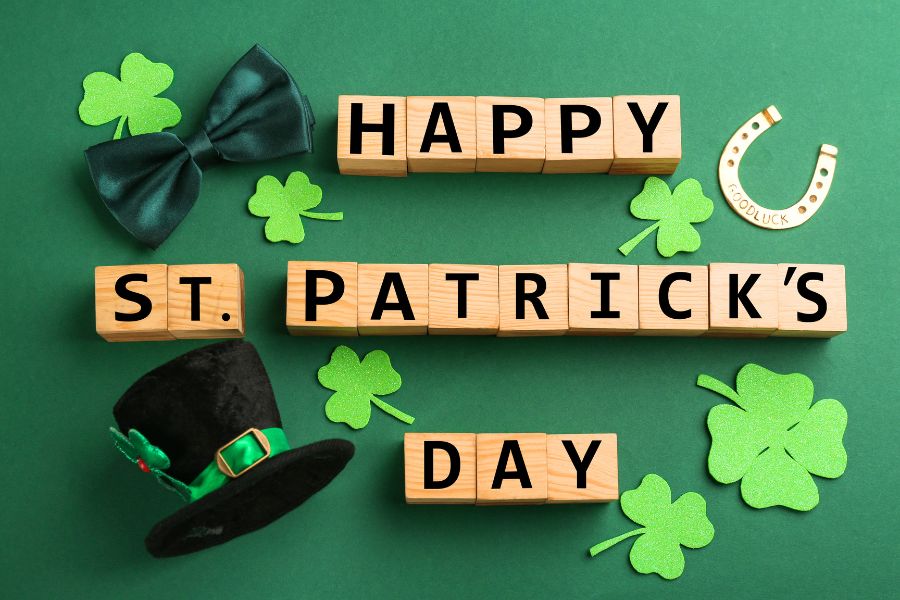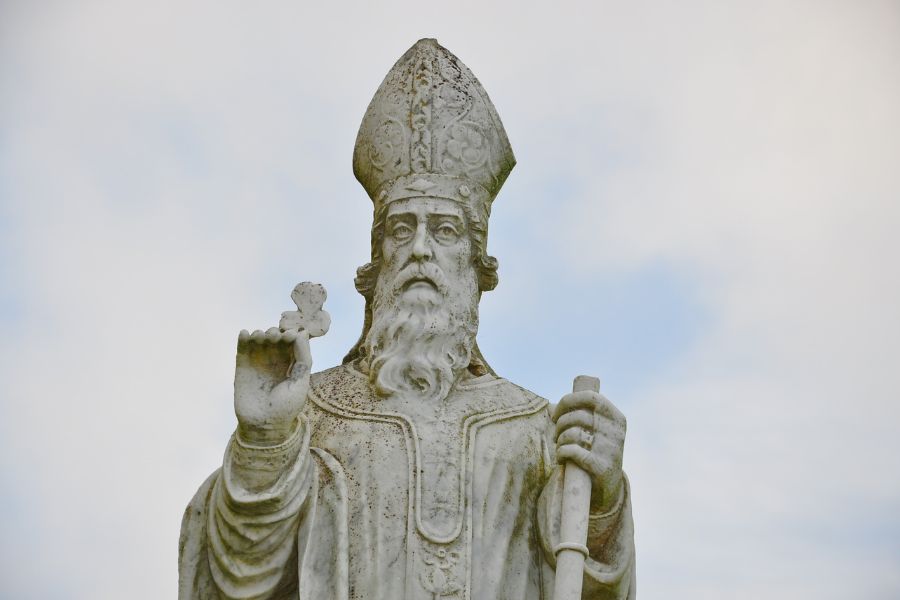Exploring the Spiritual Meaning of St. Patrick's Day
Date 3/14/2025

What is the spiritual meaning behind this beloved March holiday?
Irish heritage or not, St. Patrick’s Day is an international celebration. Whether you set up intricate “leprechaun traps” as a child or simply enjoy dressing up in green every March 17th, chances are you’ve participated in some form of St. Patrick’s Day fun. Parades fill the streets, Irish folk tunes echo through the air, and shamrocks seem to be everywhere. For many, the holiday is just that: a lively gathering and cheerful annual tradition.
But beyond the festivities, there’s a much deeper story—one that’s marked by faith, perseverance, and spiritual transformation. Who was the man who inspired this famous spring holiday? What is his connection to shamrocks and the color green? St. Patrick—and his celebration—are more than just a parade or a reason to toast “Sláinte.” His legacy helped shape the spiritual landscape of Ireland, in ways that are still felt today.
At its heart, this March feast day honors a man who dedicated his life to sharing his faith, overcoming extraordinary adversity along his inspirational journey. It’s also rich with symbolism—such as the ever-present shamrock—that provides opportunities for reflection and even reverence.
In this article, we’ll explore the spiritual meaning of St. Patrick’s Day, uncovering the profound religious significance behind the man, the holiday, and its most recognizable symbols. Plus, we’ll share ways you can add a deeper sense of purpose and meaning to your own celebrations, so you can honor both the cultural and spiritual aspects of this beloved holiday.

The Life and Legacy of Saint Patrick
The story of Saint Patrick—one of faith, resilience, and personal transformation—begins in the late 4th or 5th century CE. As a teenager he was captured, transported to Ireland, and enslaved for several years. During these trying times, St. Patrick turned to prayer as a method of survival, deepening his faith to guide him through the darkness.
St. Patrick eventually escaped and returned home, but later returned to Ireland—this time not as a captive, but as a determined missionary, intent on spreading Christianity. Through his example—his teachings, dedicated service, and deep devotion—St. Patrick played a crucial role in forming Ireland’s spiritual identity as he converted much of the island to Christianity. His legacy endures in history books and cultural celebrations not just in Ireland, but all over the world.
From Captivity to Missionary: The Journey of Saint Patrick
Little is known of St. Patrick’s earliest days. Historians estimate he was born somewhere in the late 300s to early 400s CE. Although his exact birth date remains a mystery, most sources estimate his birth around 386 CE in Roman Britain—the region of the British Isles then under Roman rule. It’s what comes next that makes his life truly remarkable.
Resilience:
His life took a dramatic turn when he was just 16 years old, when he was kidnapped by Irish raiders, taken to Ireland, and sold into slavery. For the challenging years that followed, he was forced to work as a shepherd, enduring isolation and hardship in the harsh Irish countryside. Yet it was during this time that he experienced a deep spiritual awakening. His beliefs saved him; St. Patrick deepened his faith, turned to prayer, and developed an unwavering belief in God’s purpose for his life.
Unwavering Faith:
According to his writings, St. Patrick experienced a vision in which God himself spoke to him in a dream, urging him to escape. Following this divine visit, he made his daring escape and undertook a perilous journey to find his freedom, eventually reuniting with his family. His faith remained unshaken.
But his story didn’t end there. Despite the suffering he had endured, St. Patrick couldn’t leave Ireland in his past. Instead, he felt a profound calling to return—not as a slave, but as a missionary. He spent years studying Christianity, becoming a priest and later a bishop, before undertaking his life’s greatest mission: bringing Christianity to Ireland and sharing the message of Christ with the very people who had once enslaved him.
Personal Transformation:
St. Patrick’s incredible transformation—from captive teen to spiritual leader—is a beautiful example of faith, perseverance, and forgiveness. Rather than allowing adversity to define him or defeat him, he chose to triumph through resilience and devotion. St. Patrick embraced hardship as part of his greater purpose, using it to find his divine calling. His journey is a powerful demonstration of faith overcoming challenges and how even the most difficult experiences can lead to profound personal growth and lasting change.
Saint Patrick's Role in Bringing Christianity to Ireland
His return to Ireland was not a journey of vengeance, but one of purpose. Instead of focusing on the suffering he had endured and letting it embitter him towards the Irish people, St. Patrick saw his past as a part of his divine calling. He held a steadfast belief that he had been specially chosen to bring Christianity to the Irish people. With a heart full of faith, he set out on his mission.
Connecting:
At the time, Ireland was nowhere near the Christian society St. Patrick had experienced when he lived under Roman rule. The country was deeply rooted in its pagan faith and nature-based spirituality. St. Patrick, seeing how strong these beliefs were, didn’t reject these practices outright. Instead, he took a different approach—one that allowed Christianity to grow organically, in a way that resonated with the Irish people. He took some of their familiar symbols and traditions and used them to teach Christian principles. Most famous amongst these is the shamrock—sometimes known as the 3-leaf clover—which he is said to have used to explain the concept of the Holy Trinity. St. Patrick was also wise enough to engage with local chieftains, gaining their permission to preach and to establish churches.
Persevering:
Still, St. Patrick met challenges along the way. Converting an entire nation was no small feat, especially one with such tightly held spiritual beliefs. St. Patrick faced strong resistance—even threats on his life. But his devotion to his calling never wavered. He continued doing the work he knew he was chosen to do. And over time, his influence spread. Eventually, St. Patrick’s extraordinary efforts led to the establishment of churches, monasteries, and schools that solidified Christianity in Ireland.
An Enduring Legacy:
Hundreds of years after his lifetime, St. Patrick’s legacy remains intact. Today, he is still one of the most revered figures in Irish history. The patron saint of Ireland is an enduring symbol of faith, devotion, and transformation.

Symbols and Their Spiritual Significance
You may be familiar with today’s symbols of St. Patrick’s Day. But there’s an enormous difference between the green clothing and shamrock jewelry worn for parties and the deeper spiritual symbols associated with this holiday. Because St. Patrick’s Day isn’t just a celebration of Irish culture—it’s a day rich with meaning and significance.
From the popular shamrock to the powerful words of St. Patrick’s Breastplate, many of the traditions tied to this holiday have their roots in faith, protection, and divine guidance—much like St. Patrick’s own journey. And while modern celebrations often focus on fun and festivities, these spiritual symbols offer a deeper connection to the true legacy of Ireland’s patron saint, helping you celebrate with a new sense of meaning and appreciation.
The Shamrock: A Symbol of the Holy Trinity
Of the many images associated with St. Patrick’s Day—from lucky rainbows to dancing leprechauns—none is more iconic than the 3-leaf shamrock. But beyond its connection to Irish pride and parade, the shamrock holds a deep spiritual meaning that goes all the way back to St. Patrick himself.
Before St. Patrick and his missionary journey through the country, the people of Ireland held pagan beliefs, including a spirituality rooted in nature. Seeing this, St. Patrick used familiar, nature-based symbols to explain Christian beliefs—including the shamrock. According to both Irish lore and Christian tradition, he used the shamrock to explain the concept of the Holy Trinity: the Father, the Son, and the Holy Spirit—three separate and distinct entities, united as one. Just as the shamrock has three leaves connected by a single stem, the Trinity represents three divine aspects of God, inseparable yet unique. This simple but powerful visual aid helped the saint bridge the gap between Christianity and Ireland’s existing spirituality and reverence for nature, helping the Irish people understand and accept the concept of the Holy Trinity.
Today, the shamrock persists as a symbol of faith, unity, and spiritual growth. Whether you display it as a tribute to Irish heritage and culture or for its deeper meaning, it continues to carry St. Patrick’s message: like the Trinity, we are all part of something greater.
Saint Patrick's Breastplate: A Prayer of Protection
One of the most enduring legacies attributed to Ireland’s patron saint is Saint Patrick’s Breastplate, a beautiful prayer—and sometimes hymn—for protection that has endured for centuries, and with good reason. Believed to have been written by St. Patrick himself during his mission in Ireland, this deeply moving invocation is a heart-stirring plea for God to watch over him and give him strength.
Also known as The Lorica of St. Patrick, this prayer is often described as a spiritual shield. In it, the saint calls upon Christ’s presence in all aspects of life—before, behind, above, and within him. St. Patrick’s Breastplate reflects an unwavering faith in God’s divine protection, providing both physical and spiritual refuge.
If you’re seeking strength, guidance, or divine protection, reciting this cherished prayer can bring you comfort and courage. In times of fear or uncertainty, let it remind you of faith’s ability to shield, uplift, and guide you.
The Evolution of St. Patrick's Day Celebrations
Today, St. Patrick’s Day is synonymous with parades, lively gatherings, and a sea of green. But its origins are much more solemn. The holiday that began as a religious feast day, honoring the patron saint of Ireland, has transformed into a cheerful celebration of all things Irish—culture, heritage, music, food, and community. Over the centuries, St. Patrick’s Day has evolved from quiet, reflective church services throughout Ireland to beloved parades and traditions celebrated worldwide.
From Solemn Feast to Global Festivity
St. Patrick’s Day hasn’t always been the lively, green-tinted celebration it is today. It began as a solemn religious feast day—one of the most important in Ireland—dedicated to prayer and reflection.
Like St. Patrick’s birth, the exact origins of the holiday remain uncertain. People have observed March 17th—thought to mark the anniversary of St. Patrick’s death—since around the 9th or 10th century. In 1631, the Catholic Church officially recognized St. Patrick’s Day as a religious feast day. Its intention was simple: to honor the beloved saint and his impact on Ireland’s spiritual evolution.
In its earliest days, the celebrations were modest and minimal—a simple meal with family, a time for prayer and quiet reflection. This all changed when Irish immigrants brought their traditions abroad. As Irish communities grew in cities such as New York, so did the festivities. Parades, music, and public celebrations became about more than one person. They became ways for those far from home—or born abroad—to honor their roots and express national pride. Eventually, these vibrant traditions expanded far beyond the Irish community.
Today, St. Patrick’s Day is a global phenomenon, with cities around the world celebrating the rich culture and enduring spirit of Ireland.

Modern Observances and Their Spiritual Roots
Despite the parties and parades, the spiritual essence of St. Patrick’s Day remains deeply meaningful for those who still honor its religious roots. And even amid modern festivities, elements of faith shine through.
Many attend church services dedicated to Ireland’s most famous saint, taking time to reflect on his unwavering faith. Others recite prayers, such as Saint Patrick’s Breastplate, seeking divine protection and guidance. Still others observe the day quietly, contemplating on their own faith and reconnecting with their spiritual path—as St. Patrick did.
The heart of the holiday remains unchanged, honoring St. Patrick’s legacy of devotion and perseverance—a clear reminder that faith is still worth celebrating.
Incorporating Spiritual Practices into Your Celebration
Beyond the Irish festivities, St. Patrick’s Day is an opportunity to lean into your faith and honor the day’s deeper spiritual significance. Let’s look at some of the ways you can incorporate spiritual practices into your celebration, so you can connect with the true legacy and message of Ireland’s patron saint.
Reflecting on Saint Patrick's Teachings
The celebrated saint’s life wasn’t just extraordinary—it was a testament to faith, resilience, and purpose. His personal journey, from captive to missionary, is a shining example of the power of hope and devotion, teaching powerful lessons that still apply today.
As you get ready to celebrate St. Patrick’s Day, take a moment for reflection. How can you incorporate the saint’s example into your own life? Here are some ways you can honor his teachings.
- Trust your journey. Even when faced with the greatest of difficulties, St. Patrick had faith that he was being divinely guided. Whatever challenges you’re facing today, remind yourself that you can persevere—triumph follows struggle.
- Strengthen your faith. How do you communicate with the divine? What are your spiritual beliefs? Whether you prefer prayer, meditation, or quiet reflection, make time on St. Patrick’s Day to deepen your spirituality and sense of purpose.
- Practice forgiveness. Despite the treatment he endured there, St. Patrick returned to Ireland—not with hate, but with compassion. Let his example remind you to release anger and make space for healing.
- Believe in your calling. Although he knew that Ireland’s Celtic people had their own spirituality and beliefs, St. Patrick persisted in following his purpose. What excites you; what inspires you? Take steps to move in the direction of your dreams.
- Serve others. His mission was a beautiful blend of service and transformation—let it shape yours. What are some ways you can take care of others in your community?
By practicing these lessons, you’re not just celebrating St. Patrick’s legacy—you’re living it.

Embracing Symbols with Spiritual Intent
St. Patrick’s Day is rife with symbols, from shamrocks to leprechauns to the Irish flag. But these are much more than just fun reminders—they can also be powerful tools for connecting with the true spirit of this feast day. Using them with intention can deepen your spiritual practice and bring new meaning to your holiday.
Here are some ways to incorporate the images and symbols of St. Patrick’s Day in your rituals and practices.
- Meditate with a shamrock. Return to St. Patrick’s original symbolism for the shamrock, the three leaves that represent the Holy Trinity. Take a moment to reflect on the unified yet distinct presence of the different facets of God.
- Recite St. Patrick’s Breastplate. Let this powerful prayer for protection soothe your spirit and guide your soul.
- Wear or carry symbols of faith. Let others wear a shamrock necklace for fun or good luck; you know what it truly represents. These small tokens of St. Patrick can be a powerful reminder of your spiritual beliefs and purpose.
- Practice affirmations. Let the legacy of St. Patrick inspire you to practice affirmations such as “I walk in faith” and “I am protected by the divine.”
By bringing intention to these symbols, you can elevate St. Patrick’s Day into a day filled with faith, connection, and spiritual meaning.
Common Questions About St. Patrick's Day
Have more questions about the meaning of this holiday and its spiritual significance? Here are the answers to some of the most common questions about St. Patrick’s Day.
Is St. Patrick's Day Solely a Cultural Celebration?
Not at all. While it’s often seen as a cultural holiday, St. Patrick’s Day spiritual meaning is rich and profound. St. Patrick’s Day isn’t about waving flags or wearing green—it’s a time to reflect on the life of the saint and his legacy of perseverance, faith, and divine calling. Beyond the festivities and fun, it’s your opportunity to honor the lasting impact of St. Patrick and his spiritual mission.
How Can I Honor the Spiritual Aspects of This Day?
One powerful way to honor the spiritual side of St. Patrick’s Day is through reflection and prayer. Take time to think about his message and how you can adopt it in your daily life. Perhaps reciting St. Patrick’s Breastplate, attending a church service, or meditating on faith and perseverance can encourage you to live the values he embodied.
As you ponder the teachings of St. Patrick’s, you may feel inspired to seek deeper insight into your own purpose and spiritual path. A trusted psychic advisor can help you uncover your life calling, explore your spiritual journey, and connect with your inner beliefs.

